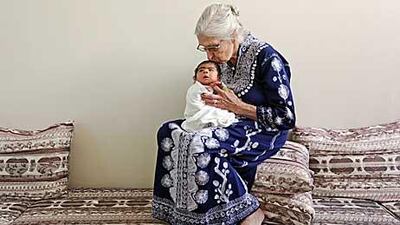FUJAIRAH // Whether it was burying a placenta in the back garden or painting walls black so women would have a place to wipe their charcoal-stained hands after cooking for new mothers, Fujairah's first midwives relied on themselves.
Now in her 70s, Wilhelmina van de Weg is no frail figure. Wearing her white hair coiled in a braid over her head and a traditional-style loose mauve dress, the woman known as Minie - or Muna to the Emirati community - welcomes friends with Dutch allspice biscuits and a familiarity that befits a woman who has delivered three generations to one family.
With her effusive energy, Minie is now working on a book with Sheikh Abdullah bin Suhail, a member of the Fujairah ruling family, and the archaeologist Michele Ziolkowski to document her life through her photographs.
"I don't like photography," said Minie. "I like people."
Minie was a pioneer in the true sense of the word. She set out on a freighter from Casablanca bound for Dubai in 1964 with her friend, Joan Elliot, who studied nursing and midwifery with her at Stobhill Hospital in Glasgow. At that time, there was only one British doctor working the coast from Muscat to Musandam.
The women trained at the Sarah Hosman Hospital with Edna Barter and Marion Willets in Sharjah for six weeks upon arrival, followed by a year-and-a-half in Ras al Khaimah, where they filled in for the nurses Helen and Glen Fearno. Then they found themselves loading their few belongings into a red Chevrolet and a blue Dodge pick-up and hitting the sand and mountains to set up the first clinic in Fujairah.
Sheikh Mohammed bin Hamad, the former Ruler of Fujairah, welcomed them with two houses: one for living and the other for working. The women set to work earning the trust of the local community.
"They had what they called a daya, it is the local midwives," recalled Minie. "The patient sat and squatted and she caught the baby. They tied the cord with filthy bits and then they put salt and curry on it.
"They didn't do like we do, cut the cord and get the baby and wait for the afterbirth to come. They waited for the afterbirth to come and then they worked, and sometimes it is not good for the baby."
The infant mortality rate was high. "If you had two out of six or seven children live it was good. There was malaria, there was diarrhoea."
Women kept their distance, distrustful until the day Minie and Ms Elliot were called to treat a woman, and her husband knew the midwives from RAK. Word spread then, and it was not long before their first Fujairah delivery.
"Oh, the woman screamed the place down, and we weren't used to it, but anyway she delivered all right. And then we got swamped, swamped, swamped and we had over a thousand in a year."
Soon women were travelling from the Batinah coast to Iran to visit the famous midwives. Women crossed the Gulf from Iran after hearing of their "powerful medicine". In fact, they had no such thing - only iron tablets to counter widespread anaemia.
Expectant mothers arrived with relatives who helped them for three days following their delivery. If none stepped forward, they paid a "sitting woman" to cook, wash nappies and bring firewood and cooking pots. The walls of the cooking room were painted dark green, and then black, to hide the sooty marks of women's hands wiped on the walls. Often, women paid more for the sitting woman than for the Dh55 delivery.
Minie and Ms Elliot were kept busy with work of their own. They acted as builders, mechanics and doctors in a community with very little. Minie tended small cuts, Ms Elliot pulled teeth. They learnt to time bread baking with deliveries so the loaf wouldn't collapse.
They boiled sheets to sterilise them and used all their might to crank their enormous generator for the power to build a foundation for the new hospital.
"We had to treat the people - there was nothing else," said Minie.
To capture the life of this tough but compassionate woman, graphic designers Victoria Algate and Salam Baldwin Khoury organised and scanned thousands of her slides for the book.
"She's very understanding of people, very observant of others' needs," said a midwife who worked with Minie in Fujairah from 1973 to 2006.
"She was always there for them, always running, always wanting to help and serve other people.
"In those days there weren't all the mechanics, and of course there were all these jobs [to do]. Electricity-wise she laid out a call system, a bell system for the hospital. My father designed it and she laid it out. She is very skilful."
A difficult childhood led Minie to dedicate the rest of her life to others.
Born in the West Java capital of Bandung, Indonesia to Dutch parents, she was put into a prisoner of war camp at age 14 for a year-and-a-half. She left for the Netherlands around 1946 for her secondary school before studying nursing and midwifery in 1952.
Ms Elliot returned to the UK in August 1975, due to ill health.
Minie still goes to the Fujairah Maternity Hospital every day.
"Working is a big word," she said. "I'm just like a liaison person. I come and see them and hug the babies."

